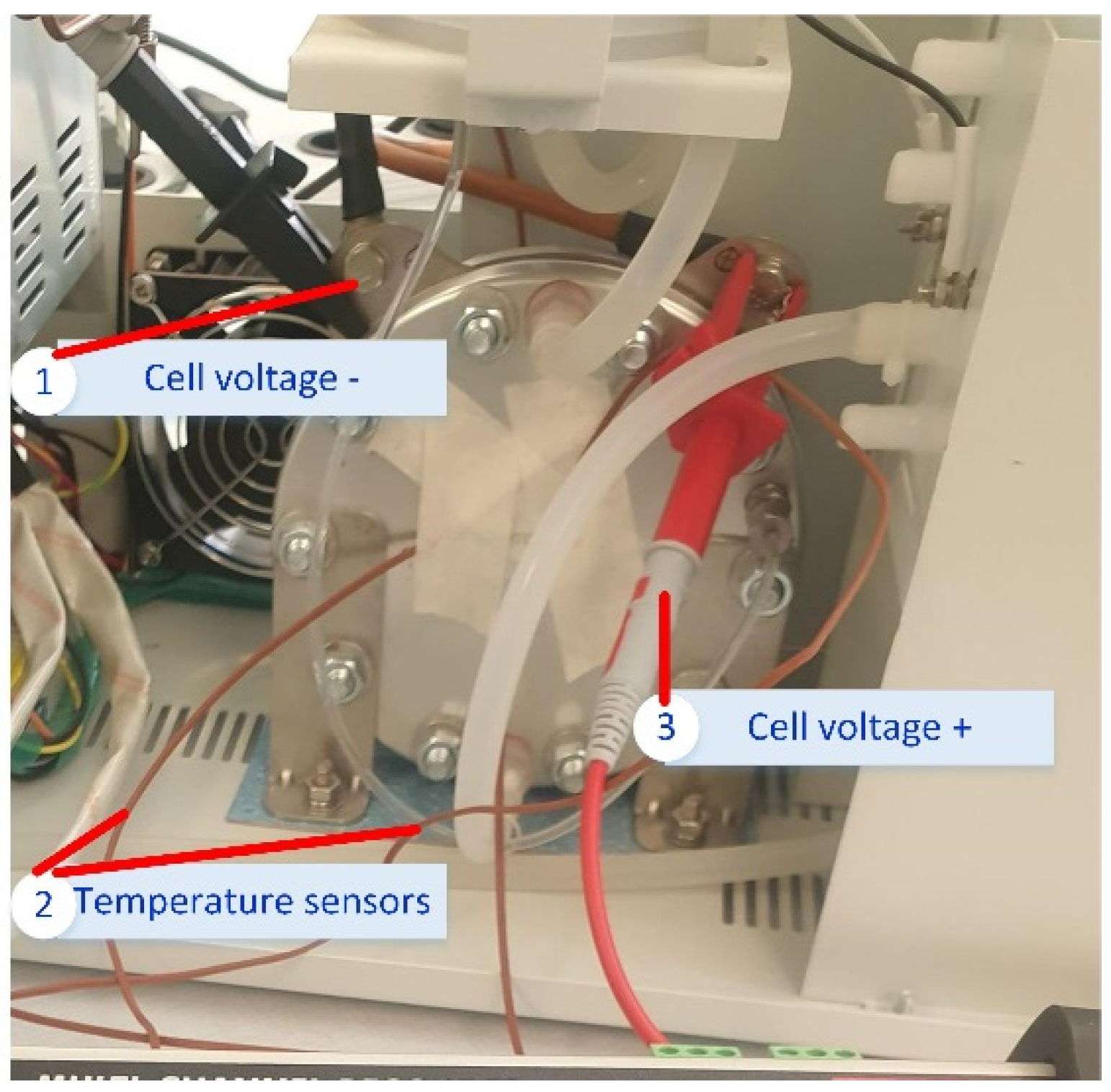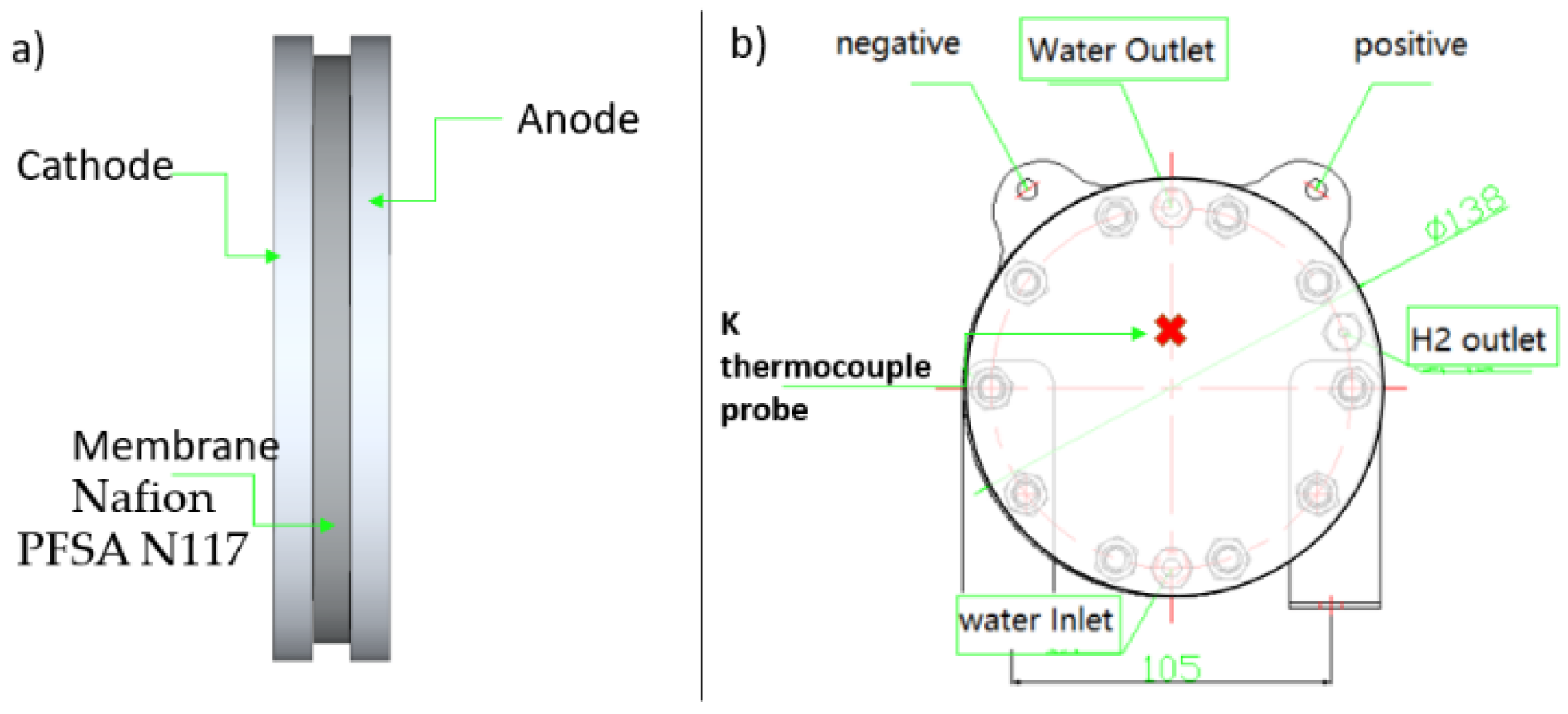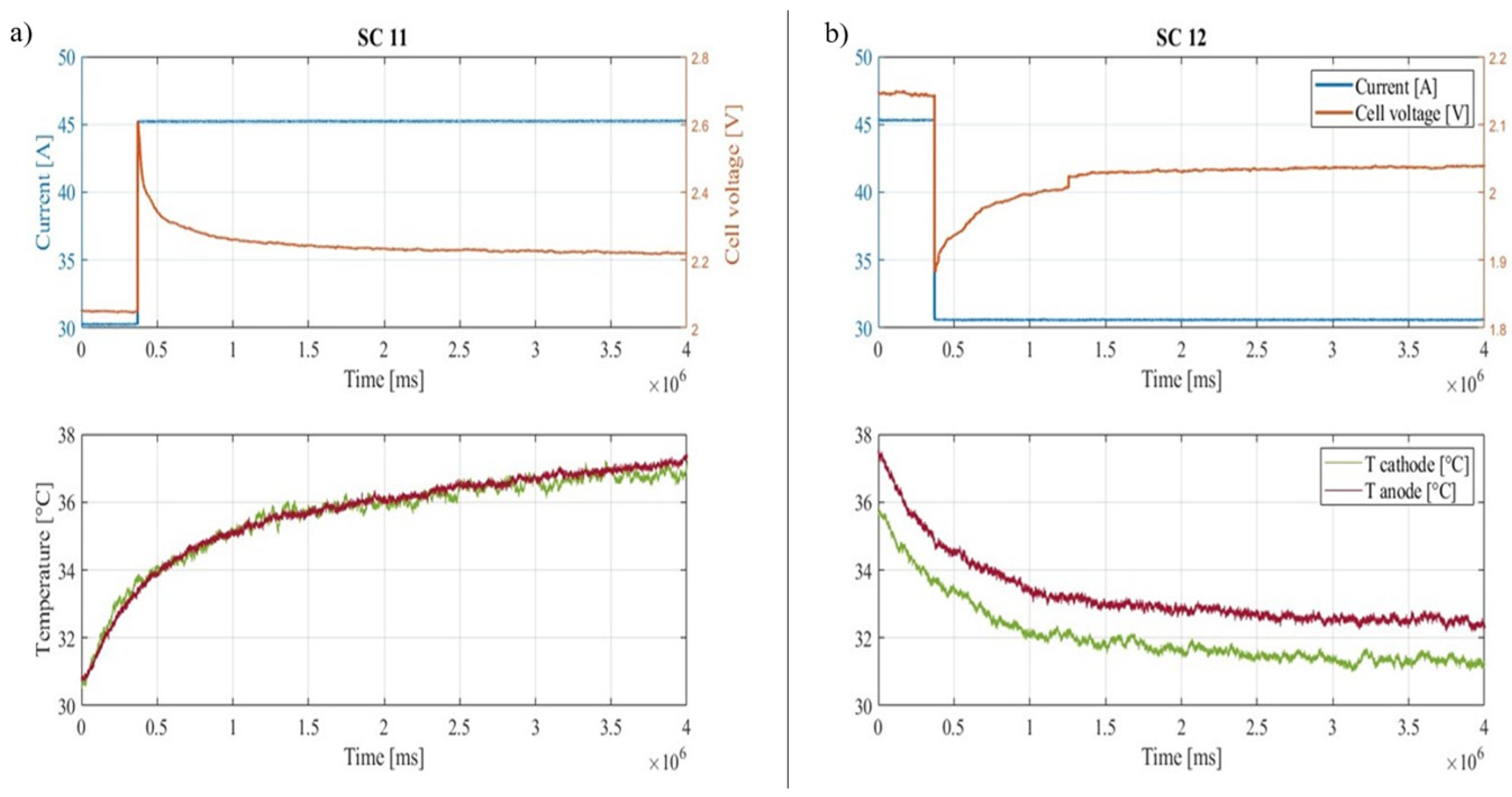Investigation of Electrical and Thermal Performance of a Commercial PEM Electrolyzer under Dynamic Solicitations
Abstract
:1. Introduction
2. Experimental Test Bench and Measurement Protocol
2.1. Presentation of the Realized Experimental Test Bench
- dSPACE control desk software;
- DS1104 controller board;
- temperature data logger;
- isolated transformer;
- PEM electrolyzer;
- voltage probe;
- current probe;
- DC power supply;
- 4-channel oscilloscope.

2.2. Description of the Measurment Protocol
3. Materials, Geometry, and Electrical and Thermal Properties of the Investigated PEM Electrolyzer
4. Experimental Results and Discussion
4.1. Obtained Experimental Results
4.2. Analysis
4.3. Discussion
5. Conclusions
Author Contributions
Funding
Institutional Review Board Statement
Informed Consent Statement
Data Availability Statement
Acknowledgments
Conflicts of Interest
References
- Ipcc.ch. Climate Change 2022: Impacts, Adaptation and Vulnerability. 2022. Available online: https://www.ipcc.ch/report/ar6/wg2/ (accessed on 23 June 2022).
- Maestre, V.; Ortiz, A.; Ortiz, I. Challenges and prospects of renewable hydrogen-based strategies for full decarbonization of stationary power applications. Renew. Sustain. Energy Rev. 2021, 152, 111628. [Google Scholar] [CrossRef]
- Yue, M.; Lambert, H.; Pahon, E.; Roche, R.; Jemei, S.; Hissel, D. Hydrogen energy systems: A critical review of technologies, applications, trends and challenges. Renew. Sustain. Energy Rev. 2021, 146, 111180. [Google Scholar] [CrossRef]
- Vincent, I.; Bessarabov, D. Low cost hydrogen production by anion exchange membrane electrolysis: A review. Renew. Sustain. Energy Rev. 2018, 81, 1690–1704. [Google Scholar] [CrossRef]
- Vincent, I.; Lee, E.; Kim, H. Comprehensive impedance investigation of low-cost anion exchange membrane electrolysis for large-scale hydrogen production. Sci. Rep. 2021, 11, 293. [Google Scholar] [CrossRef] [PubMed]
- Sebbahi, S.; Nabil, N.; Alaoui-Belghiti, A.; Laasri, S.; Rachidi, S.; Hajjaji, A. Assessment of the three most developed water electrolysis technologies: Alkaline Water Electrolysis, Proton Exchange Membrane and Solid-Oxide Electrolysis. Mater. Today Proc. 2022, 66, 140–145. [Google Scholar] [CrossRef]
- Faye, O.; Szpunar, J.; Eduok, U. A critical review on the current technologies for the generation, storage, and transportation of hydrogen. Int. J. Hydrogen Energy 2022, 47, 13771–13802. [Google Scholar] [CrossRef]
- Moradi Nafchi, F.; Afshari, E.; Baniasadi, E. Thermal and electrochemical analyses of a polymer electrolyte membrane electrolyzer. Int. J. Hydrogen Energy 2022. [Google Scholar] [CrossRef]
- Energy.gov. Hydrogen Production: Electrolysis. 2022. Available online: https://www.energy.gov/eere/fuelcells/hydrogen-production-electrolysis (accessed on 23 June 2022).
- Liso, V.; Savoia, G.; Araya, S.S.; Cinti, G.; Kær, S.K. Modelling and Experimental Analysis of a Polymer Electrolyte Membrane Water Electrolysis Cell at Different Operating Temperatures. Energies 2018, 11, 3273. [Google Scholar] [CrossRef]
- Toghyani, S.; Afshari, E.; Baniasadi, E.; Atyabi, S.; Naterer, G. Thermal and electrochemical performance assessment of a high temperature PEM electrolyzer. Energy 2018, 152, 237–246. [Google Scholar] [CrossRef]
- Sakas, G.; Ibáñez-Rioja, A.; Ruuskanen, V.; Kosonen, A.; Ahola, J.; Bergmann, O. Dynamic energy and mass balance model for an industrial alkaline water electrolyzer plant process. Int. J. Hydrogen Energy 2022, 47, 4328–4345. [Google Scholar] [CrossRef]
- Adibi, T.; Sojoudi, A.; Saha, S. Modeling of thermal performance of a commercial alkaline electrolyzer supplied with various electrical currents. Int. J. Thermofluids 2022, 13, 100126. [Google Scholar] [CrossRef]
- Khelfaoui, N.; Djafour, A.; Ghenai, C.; Laib, I.; Danoune, M.; Gougui, A. Experimental investigation of solar hydrogen production PV/PEM electrolyser performance in the Algerian Sahara regions. Int. J. Hydrogen Energy 2021, 46, 30524–30538. [Google Scholar] [CrossRef]
- Maclay, J.; Brouwer, J.; Samuelsen, G. Dynamic modeling of hybrid energy storage systems coupled to photovoltaic generation in residential applications. J. Power Sources 2007, 163, 916–925. [Google Scholar] [CrossRef]
- Aouali, F.; Becherif, M.; Ramadan, H.; Emziane, M.; Khellaf, A.; Mohammedi, K. Analytical modelling and experimental validation of proton exchange membrane electrolyser for hydrogen production. Int. J. Hydrogen Energy 2017, 42, 1366–1374. [Google Scholar] [CrossRef]
- Clarke, D.; Al-Abdeli, Y.; Kothapalli, G. The impact of renewable energy intermittency on the operational characteristics of a stand-alone hydrogen generation system with on-site water production. Int. J. Hydrogen Energy 2013, 38, 12253–12265. [Google Scholar] [CrossRef]
- Gougui, A.; Djafour, A.; Danoune, M.; Khelfaoui, N. Field experience study and evaluation for hydrogen production through a photovoltaic system in Ouargla region, Algeria. Int. J. Hydrogen Energy 2020, 45, 2593–2606. [Google Scholar] [CrossRef]
- Dieguez, P.; Ursua, A.; Sanchis, P.; Sopena, C.; Guelbenzu, E.; Gandia, L. Thermal performance of a commercial alkaline water electrolyzer: Experimental study and mathematical modeling. Int. J. Hydrogen Energy 2008, 33, 7338–7354. [Google Scholar] [CrossRef]
- Su, X.; Xu, L.; Hu, B. Simulation of proton exchange membrane electrolyzer: Influence of bubble covering. Int. J. Hydrogen Energy 2022, 47, 20027–20039. [Google Scholar] [CrossRef]
- Hernández-Gómez, Á.; Ramirez, V.; Guilbert, D.; Saldivar, B. Self-Discharge of a Proton Exchange Membrane Electrolyzer: Investigation for Modeling Purposes. Membranes 2021, 11, 379. [Google Scholar] [CrossRef]
- Falcão, D.; Pinto, A. A review on PEM electrolyzer modelling: Guidelines for beginners. J. Clean. Prod. 2020, 261, 121184. [Google Scholar] [CrossRef]
- Papakonstantinou, G.; Algara-Siller, G.; Teschner, D.; Vidaković-Koch, T.; Schlögl, R.; Sundmacher, K. Degradation study of a proton exchange membrane water electrolyzer under dynamic operation conditions. Appl. Energy 2020, 280, 115911. [Google Scholar] [CrossRef]
- Ulleberg, O. Modeling of advanced alkaline electrolyzers: A system simulation approach. Int. J. Hydrogen Energy 2003, 28, 21–33. [Google Scholar] [CrossRef]










| Parameters | Value | Unit |
|---|---|---|
| Rated electrical power | 150 | W |
| Operating voltage range | 1.4–2.3 | V |
| Current range | 0–45 | A |
| Delivery output hydrogen pressure | 0.1–10.5 | bar |
| Hydrogen purity | 99.999 | % |
| Cell number | 1 | - |
| Hydrogen volume range | 0–310 | mL.min−1 |
| SPE | 183 | µm |
| Cell active area | 150 | cm2 |
| Scenario | Value | Unit |
|---|---|---|
| SC 1 | 0–15 | A |
| SC 2 | 15–0 | |
| SC 3 | 0–30 | |
| SC 4 | 30–0 | |
| SC 5 | 0–45 | |
| SC 6 | 45–0 | |
| SC 7 | 15–30 | |
| SC 8 | 30–15 | |
| SC 9 | 15–45 | |
| SC 10 | 45–15 | |
| SC 11 | 30–45 | |
| SC 12 | 45–30 |
| Component | Material | Thermal Conductivity [W/m.K] | Electrical Conductivity [S/m] | Thickness [cm] |
|---|---|---|---|---|
| Anode | Iridium | 150 | 2.1 × 107 | - |
| Cathode | Platinum | 69.1 | 9.43 × 106 | - |
| Membrane | Nafion PFSA N117 | 0.25 | 10−3 | 183 × 10−4 |
| Scenario | Cell Voltage Range ΔV [V] | Minimum/Maximum Temperature Range [°C] |
|---|---|---|
| SC 1 | 0.04 | 23/30 |
| SC 2 | 1.56 | 24/28 |
| SC 3 | 0.52 | 17/28 |
| SC 4 | 1.91 | 23/29 |
| SC 5 | 0.60 | 18/34 |
| SC 6 | 2.05 | 24/35 |
| SC 7 | 0.67 | 23/29 |
| SC 8 | 0.28 | 25/29 |
| SC 9 | 0.70 | 25/37 |
| SC 10 | 0.49 | 29/37 |
| SC 11 | 0.38 | 30/39 |
| SC 12 | 0.11 | 32/37 |
Publisher’s Note: MDPI stays neutral with regard to jurisdictional claims in published maps and institutional affiliations. |
© 2022 by the authors. Licensee MDPI, Basel, Switzerland. This article is an open access article distributed under the terms and conditions of the Creative Commons Attribution (CC BY) license (https://creativecommons.org/licenses/by/4.0/).
Share and Cite
Mustapha, F.; Guilbert, D.; El-Ganaoui, M. Investigation of Electrical and Thermal Performance of a Commercial PEM Electrolyzer under Dynamic Solicitations. Clean Technol. 2022, 4, 931-941. https://doi.org/10.3390/cleantechnol4040057
Mustapha F, Guilbert D, El-Ganaoui M. Investigation of Electrical and Thermal Performance of a Commercial PEM Electrolyzer under Dynamic Solicitations. Clean Technologies. 2022; 4(4):931-941. https://doi.org/10.3390/cleantechnol4040057
Chicago/Turabian StyleMustapha, Feriel, Damien Guilbert, and Mohammed El-Ganaoui. 2022. "Investigation of Electrical and Thermal Performance of a Commercial PEM Electrolyzer under Dynamic Solicitations" Clean Technologies 4, no. 4: 931-941. https://doi.org/10.3390/cleantechnol4040057







